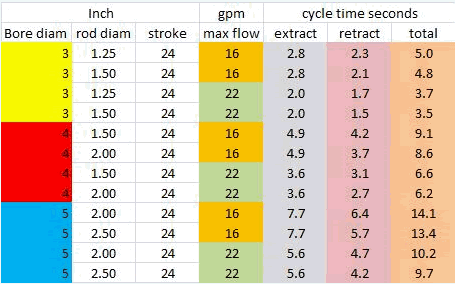Every body is talking about "how many tons" on a splitter...and no one talks about how to reduce "wedge friction"....
Friction is a VERY minor consideration in the operation of a hydraulic splitter. The friction caused by the wedge is immeasurable compared to the TONNAGE we create. What you REALLY mean is that on most splitters, "the rate of separation of wood fibers caused by the angle of attack on the wedge exceeds the yield point of the wood". This is not friction. And this varies based on wood species, condition, temperature, moisture content, and many other variables.
Most std splitters I have seen do not have very well designed splitting wedges....
They are to wide/tall...see a comparison of axes...
There is a reason why the Fiskars Super Splitter Axe perform better than other axes.....DESIGN.....
Comparing a splitter to an axe is like comparing a Corvette to my F-350. Yes, the Corvette will get you there faster, but to accomplish the same amount of work (hauling 15,000# of firewood, for example), you will have to make MANY more trips (maybe a 30:1 ratio?)!
This design technology should be applied on splitters too....that way, power could be used for increasing speed and cycle time instead of tonnage...
You do not need a 8-12" tall wedge to split a log....A 2-4" razor sharp wedge will crack a log more easily than a dull 10" one....
Power (HP) increases speed and cycle time, at the expense of fuel efficiency. Fluid pressure and increase in cylinder size increases tonnage. There is a reason we opt for a certain tonnage with hydraulic splitters... to separate wood fibers efficiently. There is NO reasonable way to transfer rotational inertia of an engine into linear speed of a wedge that anywhere near resembles the way an axe is used. The Fiskars works well because the potential energy of the axe head (mass x accelration) is applied instantaneously to a small area, creating a shock effect that the wood must respond to. There are splitters that use this concept (flywheel splitters like the Super Split) and they work GREAT! But hydraulics are designed to push the wedge through the wood, not shock it.
Another thing is that a splitter wedge need to be as sharp as possible.....if you can cut your self on a splitter wedge...it is definitely subject to sharpening
Statistically insignificant in the case of the wide wedges. Slightly significant for thinner ones. The wide wedges use the "inclined plane" concept to force the wood fibers apart. The thinner ones sometimes rely on a sheering process rather than a splitting process.
Log splitter designers have to start thinking "outside the box".....
Super Split... Screw Split... multi-wedge... etc?
Not trying to pick a fight, but the OP's question was how much tonnage is enough...
There are some of us here with engineering backgrounds that have studied splitter designs for years. Does that mean there's no room for improvement? Nope... But if you are wanting to use hydraulics to do the splitting, then use them in a manner for whiuch their strengths can best be seen. The Fiskars idea is better suited to some sort of launch mechanism like the Super Split. I'll stick with "slowly" sheering the fibers, creating 6-8 pieces of firewood with each stroke, rather than repeatedly beating on the wood, hoping it will submit at some point.








